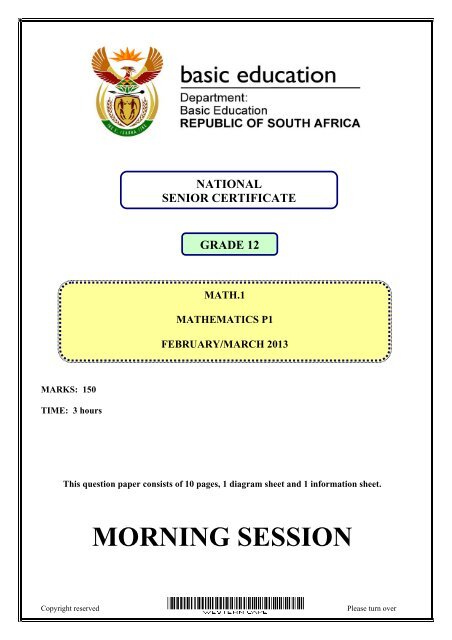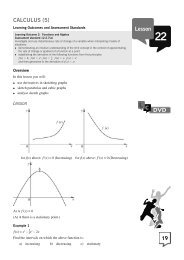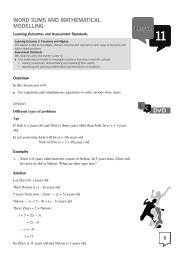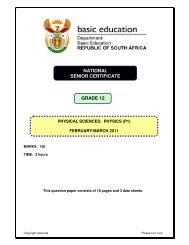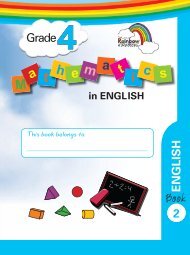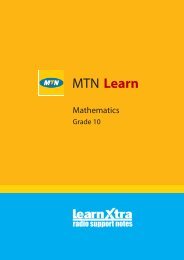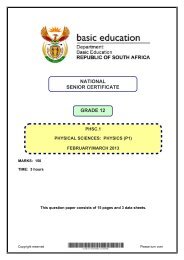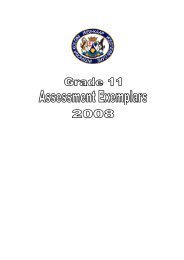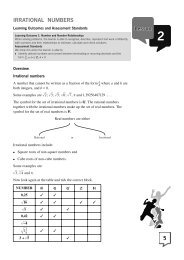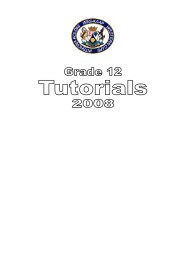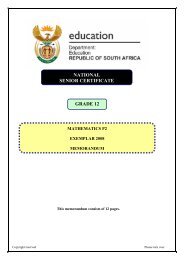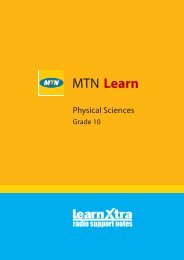MORNING SESSION - Maths Excellence
MORNING SESSION - Maths Excellence
MORNING SESSION - Maths Excellence
You also want an ePaper? Increase the reach of your titles
YUMPU automatically turns print PDFs into web optimized ePapers that Google loves.
NATIONALSENIOR CERTIFICATEGRADE 12MATH.1MATHEMATICS P1FEBRUARY/MARCH 2013MARKS: 150TIME: 3 hoursThis question paper consists of 10 pages, 1 diagram sheet and 1 information sheet.<strong>MORNING</strong> <strong>SESSION</strong>Copyright reservedPlease turn over
Mathematics/P1 2 DBE/Feb.–Mar. 2013NSCINSTRUCTIONS AND INFORMATIONRead the following instructions carefully before answering the questions.1.2.3.4.5.6.7.8.9.10.11.This question paper consists of 12 questions.Answer ALL the questions.Clearly show ALL calculations, diagrams, graphs, et cetera that you have used indetermining your answers.Answers only will not necessarily be awarded full marks.You may use an approved scientific calculator (non-programmable andnon-graphical), unless stated otherwise.If necessary, round off answers to TWO decimal places, unless stated otherwise.ONE diagram sheet is attached to answer QUESTION 12.1. Write your centrenumber and examination number on the sheet in the spaces provided and insert itinside the back cover of your ANSWER BOOK.Diagrams are NOT necessarily drawn to scale.An information sheet with formulae is included at the end of the question paper.Number the answers correctly according to the numbering system used in thisquestion paper.Write neatly and legibly.Copyright reservedPlease turn over
Mathematics/P1 3 DBE/Feb.–Mar. 2013NSCQUESTION 11.1 Solve for x:21.1.1 ( 9)( 2 1) 0x − x + =(3)21.1.2 x + x −13= 0 (Leave your answer correct to TWO decimal places.) (4)xx1.1.3 2.3= 81−3(4)1.1.4 ( x + 1)(4 − x)> 0(3)x x+21.2 Given: 2 + 2 = −5y+ 201.2.1 Expressx2 in terms of y. (2)QUESTION 21.2.2 How many solutions for x will the equation have if y = – 4? (2)1.2.3 Solve for x if y is the largest possible integer value for whichx2x+2+ 2 = −5y+ 20 will have solutions. (3)[21]2.1 Given the geometric series: 256 + p + 64 – 32 + ...2.1.1 Determine the value of p. (3)2.1.2 Calculate the sum of the first 8 terms of the series. (3)2.1.3 Why does the sum to infinity for this series exist? (1)2.1.4 Calculate S (3)∞Copyright reservedPlease turn over
Mathematics/P1 4 DBE/Feb.–Mar. 2013NSC2.2 Consider the arithmetic sequence: – 8 ; – 2 ; 4 ; 10 ; ...2.2.1 Write down the next term of the sequence. (1)2.2.2 If the n th term of the sequence is 148, determine the value of n. (3)2.2.3 Calculate the smallest value of n for which the sum of the first n termsof the sequence will be greater than 10 140. (5)∑2.3 Calculate ( 3k+ 5)30k = 1(3)[22]QUESTION 3Consider the sequence: 3 ; 9 ; 27 ; ...Jacob says that the fourth term of the sequence is 81.Vusi disagrees and says that the fourth term of the sequence is 57.3.1 Explain why Jacob and Vusi could both be correct. (2)3.2 Jacob and Vusi continue with their number patterns.Determine a formula for the n th term of:3.2.1 Jacob's sequence (1)3.2.2 Vusi's sequence (4)[7]Copyright reservedPlease turn over
Mathematics/P1 5 DBE/Feb.–Mar. 2013NSCQUESTION 4The graph ofx⎛ 1 ⎞f ( x)= ⎜ ⎟ is sketched below.⎝ 3 ⎠y0x4.1 Write down the domain of f. (1)4.2 Write down the equation of the asymptote of f. (1)4.3 Write down the equation of−1f in the form y = ... (2)−14.4 Sketch the graph of f in your ANSWER BOOK. Indicate the x-intercept and ONEother point. (3)−4.5 Write down the equation of the asymptote of f 1 ( x + 2). (2)224.6 Prove that: [ f ( x)] [ f ( −x)] = f (2x)− f ( −2x)− for all values of x. (3)[12]Copyright reservedPlease turn over
Mathematics/P1 6 DBE/Feb.–Mar. 2013NSCQUESTION 5aSketched below is the graph of g ( x)= + q .x − pC(2 ; 6) is the point of intersection of the asymptotes of g.⎛ 5 ⎞B ⎜ ; 0⎟ is the x-intercept of g.⎝ 2 ⎠ygC(2 ; 6)g0B( 5 / 2 ; 0)xa5.1 Determine the equation for g in the form g ( x)= + q(4)x − p5.2 F is the reflection of B across C. Determine the coordinates of F. (2)[6]Copyright reservedPlease turn over
Mathematics/P1 7 DBE/Feb.–Mar. 2013NSCQUESTION 62S(1 ; 18) is the turning point of the graph of f ( x)= ax + bx + c . P and T are x-intercepts of f.The graph of g ( x)= −2x+ 8 has an x-intercept at T. R is a point of intersection of f and g.yS(1 ; 18)RfgP0Tx6.1 Calculate the coordinates of T. (2)6.22Determine the equation for f in the form f ( x)= ax + bx + c . Show ALL yourworking. (4)6.32If f ( x)= −2x+ 4x+ 16, calculate the coordinates of R. (4)6.4 Use your graphs to solve for x where:6.4.1 f ( x)≥ g(x)(2)6.4.2 − 2x 2 + 4x− 2 < 0(4)[16]Copyright reservedPlease turn over
Mathematics/P1 8 DBE/Feb.–Mar. 2013NSCQUESTION 77.1 Raeesa invests R4 million into an account earning interest of 6% per annum,compounded annually. How much will her investment be worth at the end of 3 years? (3)7.2 Joanne invests R4 million into an account earning interest of 6% per annum,compounded monthly.QUESTION 87.2.1 She withdraws an allowance of R30 000 per month. The first withdrawalis exactly one month after she has deposited the R4 million. How manysuch withdrawals will Joanne be able to make? (6)7.2.2 If Joanne withdraws R20 000 per month, how many withdrawals will shebe able to make? (3)[12]Jeffrey invests R700 per month into an account earning interest at a rate of 8% per annum,compounded monthly. His friend also invests R700 per month and earns interest compoundedsemi-annually (that is every six months) at r% per annum. Jeffrey and his friend's investmentsare worth the same at the end of 12 months. Calculate r. [3]QUESTION 99.1 Use the definition of the derivative (first principles) to determine f ′(x)if3f ( x)= 2x(5)9.2dy 2 x + 1Determine if y = dx2x(4)9.32Calculate the values of a and b if f ( x)= ax + bx + 5 has a tangent at x = –1 whichis defined by the equation y = −7 x + 3(6)[15]Copyright reservedPlease turn over
Mathematics/P1 9 DBE/Feb.–Mar. 2013NSCQUESTION 103 2Given: f ( x)= −x− x + x + 1010.1 Write down the coordinates of the y-intercept of f. (1)10.2 Show that (2 ; 0) is the only x-intercept of f. (4)10.3 Calculate the coordinates of the turning points of f. (6)10.4 Sketch the graph of f in your ANSWER BOOK. Show all intercepts with the axesand all turning points. (3)[14]QUESTION 11A rectangular box is constructed in such a way that the length (l) of the base is three times aslong as its width. The material used to construct the top and the bottom of the box costs R100per square metre. The material used to construct the sides of the box costs R50 per squaremetre. The box must have a volume of 9 m 3 . Let the width of the box be x metres.hlx11.1 Determine an expression for the height (h) of the box in terms of x. (3)11.2 Show that the cost to construct the box can be expressed as1200C +x2= 600x. (3)11.3 Calculate the width of the box (that is the value of x) if the cost is to be a minimum. (4)[10]Copyright reservedPlease turn over
Mathematics/P1 10 DBE/Feb.–Mar. 2013NSCQUESTION 12A system of constraints is given below. Their boundary lines are represented graphically in thesketch below. The diagram is reproduced on DIAGRAM SHEET 1. The constraints are:y0 ≤ y ≤ 500 ≤ x ≤ 402x+ y ≤ 6035 ≤ x + y ≤ 60605550A B C D454035J302520E1510I50H G F5 10 15 20 25 30 35 40 45 50 55 60x12.1 Shade the feasible region on DIAGRAM SHEET 1. (2)12.2 Indicate which constraints have no influence on the feasible region. (3)12.3 What is the maximum value of x allowed by these constraints? (1)12.4 If P = 4 x + y for (x ; y) in the feasible region, determine the maximum value of P. (4)12.5 If the objective function C = kx + y is minimised at J only, determine ALL possiblevalues of k. (2)[12]Copyright reservedTOTAL: 150
Mathematics/P1 DBE/Feb.–Mar. 2013NSCN.B.: PLEASE HAND IN TOGETHER WITH YOUR ANSWERBOOK.CENTRE NUMBER:EXAMINATION NUMBER:DIAGRAM SHEET 1QUESTION 12.1y605550A B C D454035J302520E1510I50H G F5 10 15 20 25 30 35 40 45 50 55 60xCopyright reserved
Mathematics/P1 DBE/Feb.–Mar. 2013NSCCENTRE NUMBER:EXAMINATION NUMBER:DIAGRAM SHEET 1QUESTION 12.1y605550A B C D454035J302520E1510I50H G F5 10 15 20 25 30 35 40 45 50 55 60xCopyright reserved
Mathematics/P1 DBE/Feb.–Mar. 2013NSCINFORMATION SHEET: MATHEMATICS− b ± b2 − 4 acx =2aA = P( 1+ni)A = P( 1−ni)A = P( 1−i)nA = P( 1+i)nn∑i=11 = nCopyright reservedn∑i=1n(n + 1)i =2nn−1Tn= ara( r −1)Sn=F =xn[( 1+i)−1]ir −1T na + ( n −1)d= S = ( 2a+ ( n −1d ); r ≠ 1−nx[1 − (1 + i) ]P =if '(x)f ( x + h)− f ( x)= limh → 0 hd = ( )2( )2⎛ x1 + x2y1+ y2⎞x2 − x1+ y2− y1M ⎜ ; ⎟⎝ 2 2 ⎠y = mx + cy − y = m x − )22 2( x − a) + ( y − b) = rIn ∆ABC:sinaAarea ∆ ABC1( x1myS∞− yb c= =a2= b2+ c2− 2bc.cos Asin B sin C1=2ab.sin Cn2n)a= ; −1 < r < 11−rm = tan2 1= θx2− x1( α + β ) = sinα.cosβ cosα.sin β sin( α − β ) = sinα.cosβ − cosα.sin βsin +cos( α + β ) = cosα.cosβ − sinα.sin β cos ( α − β ) = cosα.cosβ + sinα.sin β22⎧cosα − sin α⎪2cos 2α = ⎨1− 2sin αsin 2α= 2sinα.cosα⎪ 2⎩2cosα −1( x ; y)→ ( x cosθ− y sinθ; y cosθ+ xsinθ)∑( xi− x)=2 i=1∑ fxxnn(A)P( A)= P(A or B) = P(A) + P(B) – P(A and B)ny ˆ = a + bx( S )σb=nn( x − x)∑∑2( y − y)=2( x − x)


